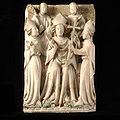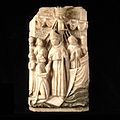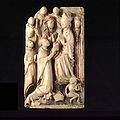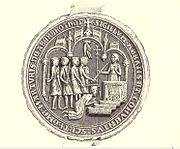
Thomas Becket
Background Information
SOS Children produced this website for schools as well as this video website about Africa. Click here to find out about child sponsorship.
| Thomas Becket | |
|---|---|
| Archbishop of Canterbury | |
 13th-century manuscript illumination, an early depiction of Becket's assassination |
|
| Province | Canterbury |
| Diocese | Diocese of Canterbury |
| See | Archbishop of Canterbury |
| Enthroned | 3 June 1162 |
| Reign ended | 29 December 1170 |
| Predecessor | Theobald of Bec |
| Successor | Roger de Bailleul |
| Personal details | |
| Birth name | Thomas Becket |
| Born | 1118 Cheapside, London |
| Died | December 29, 1170 Canterbury |
| Buried | Canterbury Cathedral |
| Nationality | English |
| Parents | Gilbert Beket Matilda |
| Sainthood | |
| Feast day | 29 December |
| Venerated in | Roman Catholic Church, Anglican Communion |
| Title as Saint | Bishop and Martyr |
| Beatified | 21 February 1173 |
| Canonized | Pope Alexander III St. Peter's Church in Segni by Pope Alexander III |
| Attributes | Sword, Martyrdom, dressed in chancellor's robe and neck chain |
| Patronage | Exeter College, Oxford; Portsmouth; Arbroath Abbey; secular clergy |
Thomas Becket (1118 – 29 December 1170), later also known as Thomas à Becket, was Archbishop of Canterbury from 1162 until his murder in 1170. He is venerated as a saint and martyr by both the Roman Catholic Church and the Anglican Communion. He engaged in conflict with Henry II of England over the rights and privileges of the Church and was assassinated by followers of the king in Canterbury Cathedral. Soon after the death of Thomas Becket, Pope Alexander III canonized him.
Name
Thomas Becket is also commonly known as "Thomas à Becket", although this form seems not to have been contemporaneous, but a post-Reformation adornment, possibly in imitation of Thomas à Kempis. Historian John Strype wrote in his Memorials of Thomas Cranmer (1694): "It is a small error, but being so oft repeated deserveth to be observed into corrected. The name of that archbishop was Thomas Becket. If the vulgar did formerly, as it doth now call him 'Thomas à Becket', their mistake is not to be followed by learned men." Notwithstanding, the Oxford Dictionary of English, the New Oxford Dictionary for Writers and Editors and Chambers Biographical Dictionary all prefer St. Thomas à Becket.
Early life
Thomas Becket was born c. 1118 in Cheapside, London, to Gilbert Beket of Thierville and Matilda (with a familiar name of Roheise or Rosea) of Mondeville near Caen. Gilbert, a knight's son, had taken the trade of mercer but in London was a property-owner, living on his rents. They were buried in Old St. Paul's Cathedral. There is a story that Thomas's mother was a Saracen princess who met and fell in love with his English father while he was on Crusade or pilgrimage in the Holy Land, followed him home, was baptised and married him. This story has no truth to it, being a fabrication from three centuries after the saint's martyrdom and inserted as a forgery into Edward Grim's contemporary (12th century) Life of St Thomas.
One of Thomas's father's rich friends, Richer de L'Aigle, was attracted to Thomas's sisters. He often invited Thomas to his estates in Sussex. There, Thomas learned to ride a horse, hunt, behave like a gentleman and engage in popular sports, such as jousting. Beginning when he was 10, Becket received a brilliant education in civil and canon law at Merton Priory in England and then in Paris, Bologna and Auxerre. Richer was later a signatory at the Constitutions of Clarendon against Thomas.
Upon returning to the Kingdom of England he attracted the notice of Theobald, Archbishop of Canterbury, who entrusted him with several important missions to Rome and finally made him Archdeacon of Canterbury and Provost of Beverley. He so distinguished himself by his zeal and efficiency that Theobald recommended him to King Henry II when the important office of Lord Chancellor became vacant. Henry accordingly appointed Becket as Chancellor in 1155.
Henry desired to be absolute ruler of his dominions, both Church and State, and could find precedents in the traditions of the throne when he planned to do away with the special privileges of the English clergy, which he regarded as fetters on his authority. As Chancellor, Becket enforced the king’s traditional medieval land tax that was exacted from all landowners, including churches and bishoprics. This created both a hardship and a resentment of Becket among the English Churchmen. To further implicate Becket as a secular man, he became an accomplished and extravagant courtier and a cheerful companion to the king's pleasures. Thomas was devoted to Henry's interests with such a firm and yet diplomatic thoroughness that scarcely anyone except perhaps John of Salisbury doubted his allegiance to English royalty.
King Henry even sent his son Henry to live in Becket's household, it being the custom then for noble children to be fostered out to other noble houses. The younger Henry was reported to have said Becket showed him more fatherly love in a day than his father did for his entire life. An emotional attachment to Becket as a foster-father may have been one of the reasons the younger Henry would turn against his father.
Primacy
He achieved his final position of power as the Archbishop of Canterbury in 1162, several months after the death of Theobald. Henry intended to further his influence by directing the actions of Thomas, his loyal appointee, and diminish the independence and influence of the Church in England. The famous transformation of Becket into an ascetic occurred at this time.
A rift grew between Henry and Thomas as the new Archbishop dropped his Chancellorship and consolidated the landed revenues of Canterbury under his control. So began a series of legal conflicts, such as the jurisdiction of secular courts over English clergymen, which accelerated antipathy between the two great offices. Attempts by King Henry to foment the opinion and influence of the other bishops against Thomas began in Westminster in October 1163, where the King sought approval of stated royal privileges. This led to Clarendon, where Thomas was officially asked to sign off on the King’s rights or face political repercussions.
- St Thomas enthroned as Archbishop of Canterbury from a Nottingham Alabaster in the Victoria & Albert Museum
The Constitutions of Clarendon
King Henry II presided over the assemblies at Clarendon Palace on 30 January 1164. In sixteen constitutions, he sought less clerical independence and a weaker connection with Rome. He employed all his skills to induce their consent and was apparently successful with all but the Primate.
Finally, even Becket expressed his willingness to agree to the substance of the Constitutions of Clarendon, but he still refused to formally sign the documents. This meant war between the two powers. Henry summoned Becket to appear before a great council at Northampton Castle on 8 October 1164, to answer allegations of contempt of royal authority and malfeasance in the Lord Chancellor's office. Convicted on the charges, Becket stormed out of the trial and fled to the Continent.
Henry pursued the fugitive archbishop with a series of edicts, aimed at all his friends and supporters as well as Becket himself; but Louis VII of France received him with respect and offered him protection. He spent nearly two years in the Cistercian abbey of Pontigny, until Henry's threats against the order obliged him to move to Sens again.
Becket sought to exercise the prerogatives of the Church, particularly the weapons of excommunication and interdict, but Pope Alexander III, though sympathising with him in theory, favoured a more diplomatic approach. Differences thus arose between Pope and Archbishop and legates were sent in 1167 with authority to act as arbitrators.
Becket's firmness seemed about to meet with its reward when, in 1170, the Pope was on the point of fulfilling his threats and excommunicating Henry II. At that point, Henry, alarmed by the prospect, held out hopes of an agreement that would allow Thomas to return to England and resume his place.
Assassination
In June 1170, the archbishop of York and the bishops of London and Salisbury held the coronation of Henry the Young King in York. This was a breach of Canterbury's privilege of coronation. In November 1170 Becket excommunicated all three. While the three bishops fled to the king in Normandy, Becket continued to excommunicate his opponents in the church. Soon word of this reached Henry.
After these reports of Becket's activities, Henry is said to have raised his head from his sickbed and roared a lament of frustration. The King's exact words are in doubt and several versions have been reported. The most commonly quoted, as handed down by "oral tradition", is "Will no one rid me of this turbulent priest?", but according to historian Simon Schama this is incorrect: he accepts the account of the contemporary biographer Edward Grim, writing in Latin, who gives us "What miserable drones and traitors have I nourished and brought up in my household, who let their lord be treated with such shameful contempt by a low-born cleric?" Many variations have found their way into popular culture.
Whatever the King said, it was interpreted as a royal command, and four knights, Reginald FitzUrse, Hugh de Morville, William de Tracy, and Richard le Breton, set out to confront the Archbishop of Canterbury. On 29 December 1170 they arrived at Canterbury. According to accounts left by the monk Gervase of Canterbury and eyewitness Edward Grim, they placed their weapons under a sycamore tree outside the cathedral and hid their mail armour under cloaks before entering to challenge Becket. The knights informed Becket he was to go to Winchester to give an account of his actions, but Becket refused. It was not until Becket refused their demands to submit to the king's will that they retrieved their weapons and rushed back inside for the killing. Becket, meanwhile, proceeded to the main hall for vespers. The four knights, wielding drawn swords, caught up with him in a spot near a door to the monastic cloister, the stairs into the crypt, and the stairs leading up into the quire of the cathedral, where the monks were chanting vespers.
Several contemporary accounts of what happened next exist; of particular note is that of Edward Grim, who was himself wounded in the attack. This is part of the account from Edward Grim:
...The wicked knight leapt suddenly upon him, cutting off the top of the crown which the unction of sacred chrism had dedicated to God. Next he received a second blow on the head, but still he stood firm and immovable. At the third blow he fell on his knees and elbows, offering himself a living sacrifice, and saying in a low voice, 'For the name of Jesus and the protection of the Church, I am ready to embrace death.' But the third knight inflicted a terrible wound as he lay prostrate. By this stroke, the crown of his head was separated from the head in such a way that the blood white with the brain, and the brain no less red from the blood, dyed the floor of the cathedral. The same clerk who had entered with the knights placed his foot on the neck of the holy priest and precious martyr, and, horrible to relate, scattered the brains and blood about the pavements, crying to the others, 'Let us away, knights; this fellow will arise no more.
Following his death, the monks prepared his body for burial. According to some accounts, it was discovered that Becket had worn a hairshirt under his archbishop's garments—a sign of penance. Soon after, the faithful throughout Europe began venerating Becket as a martyr, and in 1173 — barely three years after his death — he was canonised by Pope Alexander III in St. Peter's Church in Segni. On 12 July 1174, in the midst of the Revolt of 1173–1174, Henry humbled himself with public penance at Becket's tomb (see also St. Dunstan's, Canterbury), which became one of the most popular pilgrimage sites in England.
Becket's assassins fled north to Knaresborough Castle, which was held by Hugh de Morville, where they remained for about a year. De Morville held property in Cumbria and this may also have provided a convenient bolt-hole, as the men prepared for a longer stay in the separate kingdom of Scotland. They were not arrested and neither did Henry confiscate their lands, but he failed to help them when they sought his advice in August 1171. Pope Alexander excommunicated all four. Seeking forgiveness, the assassins travelled to Rome and were ordered by the Pope to serve as knights in the Holy Lands for a period of fourteen years.
The monks were afraid that Becket's body might be stolen. To prevent this Becket's remains were placed beneath the floor of the eastern crypt of the cathedral. A stone cover was placed over the burial place with two holes where pilgrims could insert their heads and kiss the tomb; this arrangement is illustrated in the 'Miracle Windows' of the Trinity Chapel. A guard chamber (now called the Wax Chamber) had a clear view of the grave. In 1220, Becket's bones were moved to a new gold-plated and bejewelled shrine behind the high altar in the Trinity Chapel. The shrine was supported by three pairs of pillars, placed on a raised platform with three steps. This is also illustrated in one of the miracle windows. Canterbury, because of its religious history, had always seen a large number of pilgrims. However, after the death of Thomas Becket, the number of pilgrims visiting the city grew rapidly.
In 1220, Becket's remains were relocated from this first tomb to a shrine in the recently completed Trinity Chapel where it stood until it was destroyed in 1538, around the time of the Dissolution of the Monasteries, on orders from King Henry VIII. The king also destroyed Becket's bones and ordered that all mention of his name be obliterated. The pavement where the shrine stood is today marked by a lit candle. Modern day archbishops celebrate the Eucharist at this place to commemorate Becket's martyrdom and the translation of his body from his first burial place to the new shrine.
Aftermath
Becket's last public act of defiance was a sermon to the Augustinian foundation at St. Mary's Priory at Southwark on 23 December, now the Cathedral. He then left for Canterbury by the principal route to Kent from there, now the A2 road. The pilgrimage started shortly after the murder, encouraged by the Augustinian orders at both Southwark and Canterbury, as a retracing of Becket's last journey. This was given added impetus with Becket's canonisation in 1173. The Pilgrimage had very strong advantages to those participating as it was relatively a short distance, between two major cities across a well policed area, convenient and affordable by a larger class of penitents. This contrasted with, for example, pilgrimages to the Holy Land, Saint-Denis, Paris or St. Peter's Basilica, Rome, or Santiago de Compostella across the Pyrenees, and the ' indulgences' and other religious benefits were as great. So successful was this procession that it led to the reconstruction of London Bridge, firstly in timber and then in stone, which included a chapel dedicated to Thomas on it. The pilgrims both began and ended their journey with devotions there. The new traffic generated economic development in Southwark, increasing its urban density and creating the long line of inns and hostelries along the High Street. Furthermore, due to the number of sick pilgrims hoping for a miraculous cure and arriving too unwell to continue, an infirmary was created by the Augustinians at St. Mary's Priory (near the bridge-foot). It became dedicated to Becket, and was relocated from the precincts to a site now called St Thomas Street, a little to the south, not later than 1212. This is the origin of St Thomas' Hospital.
As the scion of the leading mercantile dynasty of later centuries, Mercers, Becket was very much regarded as a Londoner by the citizens and was adopted as the City's co-patron saint with St Paul: both their images appeared on the Seals of the City and of the Lord Mayor. The Bridge House Estates seal used only the image of Becket, while the reverse featured the depiction of his martyrdom.
Local legends regarding Becket arose after his canonisation. Though they are typical hagiographical stories, they also display Becket’s particular gruffness. Becket's Well, in Otford, Kent, is said to have been created after Becket had become displeased with the taste of the local water. Two springs of clear water are said to have bubbled up after he struck the ground with his crozier. The absence of nightingales in Otford is also ascribed to Becket, who is said to have been so disturbed in his devotions by the song of a nightingale that he commanded that none should sing in the town ever again. In the town of Strood, also in Kent, Becket is said to have caused the inhabitants of the town and their descendants to be born with tails. The men of Strood had sided with the king in his struggles against the archbishop, and to demonstrate their support, had cut off the tail of Becket’s horse as he passed through the town.
The saint's fame quickly spread throughout the Norman world. The first holy image of Becket is thought to be a mosaic icon still visible in Monreale Cathedral, in Sicily, created shortly after his death. Becket's cousins obtained refuge at the Sicilian court during his exile, and King William II of Sicily wed a daughter of Henry II. The principal church of the Sicilian city of Marsala is dedicated to St. Thomas Becket. Over forty-five medieval chasse reliquaries decorated in champlevé enamel showing similar scenes from Becket's life survive, including the Becket Casket in London ( V&A Museum). He is commemorated by a statue in niche 196 of the west front of Salisbury Cathedral.












